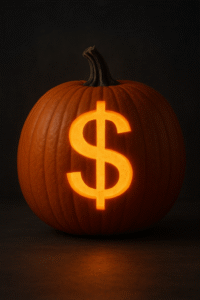Halloween is the perfect time for scary stories, and while most people think of ghosts and goblins, investors know that true terror comes in a different form: watching your portfolio plummet while the financial world seems to be ending. Let’s look at three of the most devastating market crashes in recent history.

Black Monday: October 19, 1987
The Dow Jones Industrial Average plunged 22.6% in a single trading session—the largest single-day percentage decline in stock market history. There was no gradual decline to prepare you, no warning signs. Just one brutal day that wiped out more than a fifth of the market’s value.
Phone lines to brokers were jammed. Trading systems were overwhelmed. Investors faced terrifying questions: Is this another Great Depression? Should I sell everything before it gets worse?
The real horror wasn’t just the single-day loss—it was the uncertainty that followed. If you were planning to retire in 1988 or needed money for a down payment, you faced an impossible choice: sell at massive losses or find another way to get the cash you needed. The market took two years to recover. For investors who panicked and sold, those losses became permanent.
The Dot-Com Bubble: 2000-2002
Between March 2000 and October 2002, the NASDAQ composite index fell 78% from its peak. A $100,000 tech-heavy portfolio shrank to just $22,000.
Unlike Black Monday’s single catastrophic day, this was a slow-motion train wreck lasting more than two years. Month after month, investors watched their portfolios bleed value. Each quarterly statement brought fresh pain.
The investors who suffered most had concentrated their portfolios in technology stocks, believing the boom would never end. Some had their entire retirement in their employer’s tech company stock.
If you were retiring in 2001 or 2002, you faced a nightmare: delay retirement, drastically cut your lifestyle, or sell at the bottom? The NASDAQ wouldn’t return to its 2000 peak until 2015—fifteen years later. Investors who needed their money during those years had no choice but to realize their losses.
The 2008 Financial Crisis: When Everything Fell Apart
The S&P 500 fell 57% from peak to bottom. Major financial institutions failed or required government bailouts. Unemployment soared. Home values collapsed.
What made 2008 particularly horrifying was the speed and severity combined with the sense that the system itself might not survive. During the worst weeks in September and October 2008, even diversified portfolios offered little protection. Every day brought new headlines of banks failing and economists warning of potential depression.
For investors, the emotional toll was enormous. Watching your retirement account lose half its value while worrying about job security and home values created a perfect storm of financial anxiety.
If you were 66 in early 2009, newly retired or about to retire, you faced a crisis. Your portfolio was down 50% or more, and you needed to start drawing income. Every withdrawal meant selling at depressed prices, locking in losses and reducing the portfolio’s ability to recover.
The market regained its pre-crisis peak by 2013, but for investors who sold in panic or were forced to withdraw money during the downturn, the damage was permanent.
The Lesson: Why Horror Stories Merit Having an Advisor
These crashes share common threads: they all felt like “this time is different,” and they all created impossible situations for investors who needed their money before the recovery.
An advisor’s job isn’t to predict crashes or time the market perfectly. It’s to help you build a portfolio that can weather storms based on when you’ll actually need your money. It’s to keep you from making panicked decisions when everything feels like it’s falling apart.
Market crashes are inevitable. The real horror story isn’t the crash itself—it’s being unprepared for it, or worse, making fear-based decisions that turn temporary losses into permanent ones.


